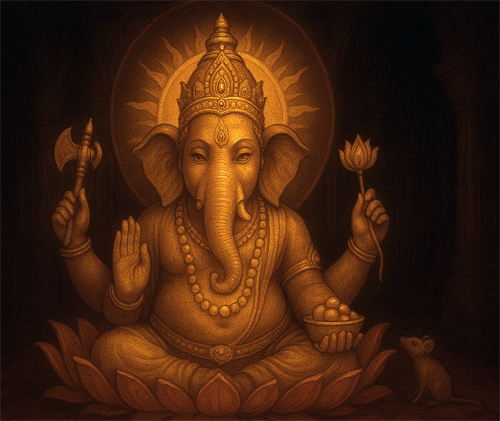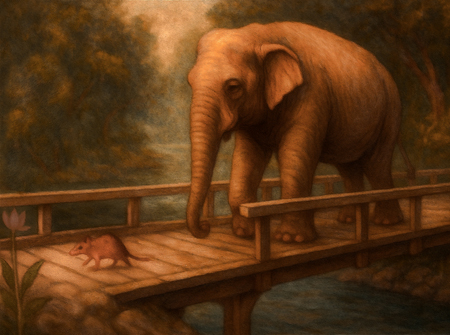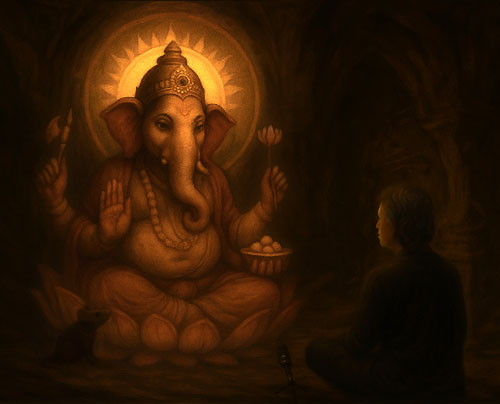Ganesha’s image
The interview below with Ganesha discusses the many spiritual properties of this ancient Hindu deity. Ganesha’s words are adapted to the present time. Ganesha is the Remover of Inner Obstacles.
Interview with Ganesha
.
Good day, Lord Ganesha.
How wonderful that I may interview you!
But of course. And you can just call me Ganesh.
Oh, thank you! Could you tell me who you are?
I’d be happy to.
I am, as the god of knowledge and wisdom, the son of Śiva and Pārvati, who together symbolize the unity of all. Shiva stands for subjective consciousness, and Pārvatī for the energetic material. As a god, I remove obstacles and have thus become the patron of travelers on the path to self-realization. I’m also known as Ékadānta, One‑Tusk, and as Vignāhartha, which means ‘remover of obstacles’, in both the physical and spiritual sense. I’m also called Mangal Murti, the benevolent one. I have many names and am very ancient, more than eighteen hundred years old.
Wow! That’s impressive! And what exactly do you do?
When one turns to me for any work, especially spiritual work, obstacles dissolve and success is achieved in that Work. I always feel happy when I bestow my blessings, even if I’m honored or offered little. People say I’m the friendliest god and love to freely give my blessings. Well… that’s true!
You are popular! I notice you now appear in everyone’s homes, or by a pond in the garden.
Yes, that’s true. My appearance is beloved. But what matters for me as a deity is, of course, what I stand for. If that doesn’t also have value for the owner, they might as well place a garden gnome.
Indeed…
I see you’ve taken on the form of some kind of elephant. But quite an odd one, since there’s so much more to you.
That’s correct. I may appear as an elephant, but I represent much more. Obviously, an elephant like me doesn’t roam the earth. But I didn’t randomly choose an elephant’s body. An elephant is large, powerful, majestic, and also calm and deliberate in its manner. But it also has the potential to destroy.
My large head stands for intelligence and contains vast thinking capacity. My tusks, one of which is broken, stand for preserving what is good and leaving behind what no longer serves us. They are also weapons — one for defense and the other for offense… but I laid the latter down. My huge belly can digest much — the good and the bad — and my heart is big. My sharp eyes are focused and see everything, and with my large ears I can listen well to everyone, symbolizing my power of inner hearing.
What do you mean by a great capacity for inner hearing?
Well, that is the capacity to internally receive the highest and most refined information. True knowledge: information that cannot actually come ‘from the outside’.
Aha! A kind of antenna, then?
Yes, you could call it that, but more like a very large satellite dish!
I also see you have many more limbs than an elephant. I count four arms, and your hands are holding various things.
Yes, my embodiment has four arms—just as there are four directions in the world. With these, I offer various things to the whole world.
Would you explain this fourfold offering to me, Ganesh?
 Certainly. First, my lower right hand is in the gesture of greeting and blessing. I greet and bless the world and declare my loving peace. Just as Native Americans long ago showed their palms as a sign of peace, I show that I am completely nonviolent toward those who love the truth.
Certainly. First, my lower right hand is in the gesture of greeting and blessing. I greet and bless the world and declare my loving peace. Just as Native Americans long ago showed their palms as a sign of peace, I show that I am completely nonviolent toward those who love the truth.
But this hand also says more: viewed differently, it’s also in a gesture of refusal. This shows that nothing untrue can ever reach me. With this, I keep all falsehood and projections from the world at bay.
That’s clear. And your hand behind that? I see you’re holding an axe.
That’s right. It’s the axe of the highest discernment. Like a surgeon’s scalpel cutting away diseased tissue, it severs falsehood from the true and healthy. It frees the person from identifications, conditionings, and misconceptions by cutting through unnatural attachment. In short, it liberates the person from all tendencies that keep him ignorant, small, and selfish. I also sometimes use a rope to remove inner obstacles like these.
And your upper left hand holds a beautiful flower.
Yes, the lotus flower — the flower of pure love and beauty. A gift to the world of all that is good, pure, and beautiful and loving, for those who wish to receive it.
I am often depicted seated on a great lotus flower, because this sacred flower symbolizes divine birth and purity. The lotus floats on water and self-cleanses, never clinging to soil or dirt. In the spiritual world, water stands for inner-flowing truth. Thus, the inner lotus blooms upon truth.
Beautiful!
Your other left hand appears to offer a bowl of something delicious. Is that correct?
Exactly! My left hand also gives, offering all that is delicious and nourishing, all abundance, all that is pleasant — all the fruits of existence in truth. For there is abundance for everyone who can receive, for everyone who can relax clenched fists into open, receptive hands.
So, that’s it? What your image tells us?
Oh no. This is just the beginning. I also have a trunk. A particularly handy limb with many beautiful attributes: flexible, multifunctional, breathing, and grasping. It is my fifth ‘arm’, and along with my other arms represents the five senses that bring understanding.
For senses enable the experience of meaning and make life the celebration to which all people are invited! ‘Gadget’ stands for ‘instrument that makes possible’. Just as a vessel enables sailing and a carriage enables transport, the senses enable the experience of meaning.
And your legs?
Good observation! In total I have seven limbs. Altogether they stand for the law of seven, also known as the law of octaves. Let me explain. Seven is a sacred number, expressed in a universal law recognizable in our creation. In music, this law is clearly visible in our seven‑note scales. All around the world people make music with seven notes, sprinkled with the remaining notes in the octave, which is subdivided into twelve parts.
Yes… I was just thinking… there are indeed twelve notes?
Indeed. The number twelve is also a sacred number and serves as a refinement and completion of the law of seven. You know our time divisions: we don’t have seven days in a week or twelve months in a year by accident… or two times twelve hours in a day, a dozen, a gross — it all expresses laws.
But the law of seven works alongside its visible manifestation as an esoteric path in our inner world. There is much more to say…
I’d love to hear more about that another time.
I see behind your head a huge sun.
Yes, that is the sun of the eternal light of Consciousness. This inner sun shines in every human, in every being. However, due to humanity’s illusion of separation, this sun is usually no longer experienced: there is too much shadow in one’s mind. This inner sun of Consciousness truly gives everything power and energy! That will be revealed to humans as soon as they realize it… uh… who said that again?
Yes haha, that was a Dutch philosopher… I also interviewed him…
And what do I see there? You also have a large mouse at your feet!
That’s right. His name is Maśhīka, which means mask. But actually he is a bandicoot, a pouch‑rat, and looks like a very large mouse. He is dear to me, for he is my vāhana, my vehicle. He is always with me and stands for the personality and ego of the human — for all that a person acquires and learns during their life, from birth onward. These are all the acquisitions that enable a person, as an individual, to relate to the world, proceed in it, and act… in every situation and at every moment. Man cannot do without his mouse.
Why a mouse and not, say, a dog or a horse?
Well, it aptly illustrates the relationship between the Self within the human and his personality. A tremendous difference in size, see? Yet a person, in his grand true state cannot do without a ‘mouse’, his personality, which serves him in navigating in the world and with the world, yet without becoming of the world. But the mouse is stubborn, with its pointed wise nose… so every person must watch out for its stubborn tricks. Every single day! Despite all its fantastic qualities, it’s still a very disobedient creature if it doesn’t listen to its master! ‘Mouse’ comes from the Sanskrit word mūṣaka derived from the root mūṣ, meaning ‘to steal’. It likes to run off with all my divine merits, haha, thinking they are its own merits.
Oh really? Please explain that to me a little more.
Okay, as the final point then.
The mouse wants to be bigger than it is. To create this illusion, it identifies with all sorts of things, making it forget me, its true Master. Then it settles for its small stature. Or it thinks it is the boss of me. Then it thinks it can exist without me, which is absolutely impossible.
 Here is a little joke that illustrates this:
Here is a little joke that illustrates this:
An elephant and a mouse go out together. At some point they come to a wooden bridge over a river. This bridge resonates beautifully with the elephant’s heavy steps. Then the mouse suddenly exclaims in full enthusiasm to the elephant: “I’m stomping really nice, huh?!”
Hahaha! Brilliant!
Where can I find you, Lord Ganesha, if I need you?
Within you, young friend, within yourself!
Well, thank you very much!

